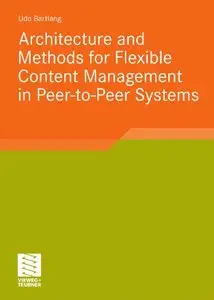Architecture and Methods for Flexible Content Management in Peer-to-Peer Systems by Udo Bartlang
English | 24 Feb. 2010 | ISBN: 3834810231 | 240 Pages | PDF | 2 MB
English | 24 Feb. 2010 | ISBN: 3834810231 | 240 Pages | PDF | 2 MB
At times when the IT manager's best friend is systems consolidation (which is a euphemism for centralisation), it may come somewhat as a surprise for you that this book investigates decentralisation in the context of content management systems. It may seem quite obvious that content will and should be managed by the party who creates and owns the content, and hence should be held in a-somewhat-centralised and managed location. However, over the past few years, we have been witnesses of some important trends and developments which call for novel ways of thinking about content management and maybe even broader, about computer systems in general. First, ongoing business globalization creates natural distribution of information at a corp- ate level, as well as decentralization of control over business resources and business processes. Changing alliances with partners require ?exible architectures for content management that canadapttochangingconstellations, roles, andaccessrights. Second, theneedforoutsourcing and resource e?ciency has brought about concepts of virtualization, recently culminating in the cloud computing buzzword. Virtualization of content management services requires - tremely scalable and ?exible underlying information and communication architectures. These kinds of solutions are theoretically and practically impossible to implement based on c- tralised client-server architectures. Third, we are currently experiencing a dramatic shift in the roles of consumers in the Internet. The times have gone when quality content was only delivered by publishers and news agencies. Wikis and other Web 2. 0 tools empower consumers to produce and publish their personal content.



